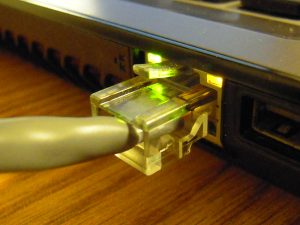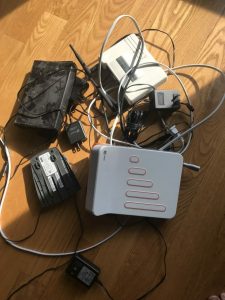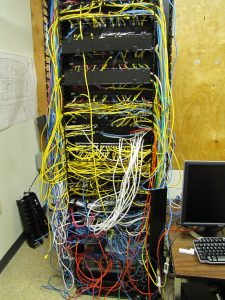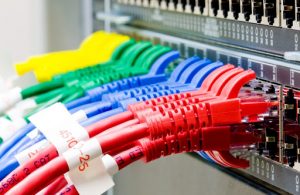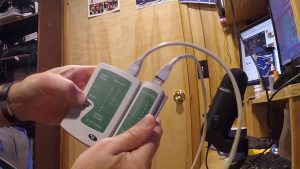Your cabling layout is critical infrastructure. Getting it right matters.
So, Contact Us. We can help.
The ethernet infrastructure that supports your facility is just as important as the electrical wiring or the waterworks; if it goes down, business grinds to a halt. If it underperforms, getting anything done will be a painful, arduous process. And, if shortcuts or sloppy workmanship played a role in the initial installation, fixing those problems could take a lot longer, and cost a lot more money.
Many mistakes can be easily made when it comes to industrial ethernet installations and maintenance. Fortunately, they can be just as easily avoided with some diligent planning. If you have any questions, you can Contact Us anytime.
Seeing the Light, and Trusting It
The LED link light is no indication of how well your cabling layout is performing. It’ll light up whether your network is performing optimally or barely at all. That’s a wide gulf, and if you don’t have experienced network technicians to rely on, you’ll be left scratching your head, trying to figure out why your network is underperforming.
Replacing Gear Randomly, and Hoping for the Best
When your network goes down, the outage can light a fire under a lot of people. There’s a real sense of urgency to get it back up and running and, because of that, there might be the temptation to start replacing controllers and swapping out cables until communications come back online, even partially. There are a few problems with this guesswork approach.
First off, it’s random. You haven’t figured out what the cause of the outage was or the extent to which you ‘fixed’ it. Secondly, it’s time-consuming and potentially expensive. You could wind up buying replacement cable or equipment unnecessarily. And third, because you didn’t determine what the problem was, you haven’t prevented it from happening again.
Using Lower Grade Ethernet Cables
Consumer or commercial grade ethernet cabling might get the job done, as far as providing connectivity goes, but it’s not built to the same standards as industrial grade. Remember, it’s designed to be used in a condo complex or an office tower, not a smelting plant or an oil refinery.
Industrial grade ethernet cabling is designed to withstand harsher environmental conditions like moisture, electromagnetic interference (from machinery), chemicals, heavy vibration, and all the other rugged environmental factors that make up your work environment. The consumer-grade product might give you the bandwidth you need initially, but it won’t stand up to the rigors of your facility. And once it fails, the problems it creates could outweigh any money you saved.
A Careless Layout
Industrial ethernet cabling is generally designed to stand up to harsher treatment (higher temperatures, more EM interference) than office-grade, but it isn’t invulnerable. When routing your cable, you’ll still need to take the environment into account. You have to know if there’s a chance your cables will be exposed to water, chemicals, extreme temperatures, and other rugged environmental conditions. If you don’t plan around them, you could be setting yourself up for disaster. And, the worst part is that you won’t notice a gradual decline in performance as your cabling takes a beating. The failure will be sudden and unexpected.
Not Labelling
It’s been said before, and it bears repeating: label your cables. Your layout has to be built with the expectation that moves, add-ons, decommissioning, or changes will take place. If you don’t know which cables support a given piece of network infrastructure, figuring that out will be a painful process. It’s more than likely you’ll end up shutting down the wrong part of your network before you’re done.
Not Inspecting or Testing Cabling Before Installation
Making sure that your cabling works as expected, is cut to the right length, and is terminated properly are just a few of the tests you can do before installation. These tests can be done relatively quickly and doing them will avoid the need for hours of troubleshooting (and frustration) when some parts of the installation inevitably fail.
There are additional tests you can perform, post-installation, that measure how well your cable will perform. Doing these tests is just as worthwhile as any pre-installation inspection. You’ll find out what problems exist well ahead of time, allowing you to solve them and ensure your network can support your operation, long-term.
Not Having Spares
As good as your cabling infrastructure may be, problems will eventually occur, most likely with the connectors or the cables themselves. When that happens, the preparation you took ahead of time will make the difference between hours of downtime and days of downtime.
One way to prepare is by having spare connectors and cabling on-hand so your team doesn’t have to waste time sourcing equipment. Another step you can take is having the expertise either on-hand (in your staff) or on-call so repairs can be made immediately.
Not Cleaning and Inspecting your Fiber
If your cabling layout has a fiber optic component, then be advised: Contamination is the main reason that fiber optic cables underperform. Dirt, dust, and oil can build up on the endpoints of fiber optic cables, especially in industrial environments like pulp mills and refineries. After all, these endpoints are where the cable connects to hardware, meaning the interior is relatively unprotected. Dirt, dust, and oil can easily build up here.
Be sure to inspect and clean these endpoints whenever they are disconnected and reconnected to hardware, and you’ll mitigate the chance of contamination causing performance issues.
Getting Started
The general theme of all of these common – and easily avoidable – mistakes are taking shortcuts. Failing to plan, failing to test, buying lower-grade gear, and neglecting to buy spares are all choices that can seem like time and money savers at first but can end up costing you more than you bargained for. Invest in getting the job done right from the beginning, and your cabling system will be on solid footing.
If you have questions about how best to plan, or if you’d like to discuss maintenance and inspection, Contact Us. Our Account Managers, Cabling Technicians, and Fiber Optic Technicians are here to help.
Tridon is a full solution Telecom Systems Integrator with CSA certification and licensed by APEGA. Our Engineering, Service, and Tower Divisions collaborate with customers to build engineered solutions including communications systems design, tower inspections, and co-location, wireless broadband, fiber optic cabling, site security, and two-way radio communication.

